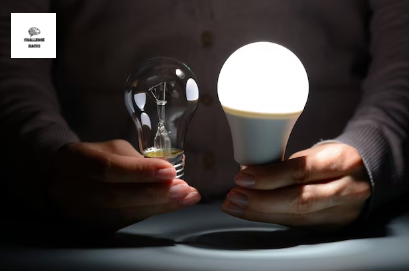
Choosing a light bulb can be overwhelming with so many options available. Maybe you’ve been examining the labels, asking yourself, “Should I get a Par16 or a Par20?” without recognizing the differences between them that extend beyond appearance. I aim to help you by explaining these two types of smart bulbs.
We will discuss Par16 and Par20 Smart Bulbs Compared their appearance, dimensions, energy efficiency, and compatibility with different light fittings. When you finish reading this post, you will know exactly which light bulb will brighten up your home! Let’s begin.
Which Smart Bulbs Are Par16 and Par20?
PAR16 and PAR20 bulbs might look like cryptic codes to many, but they’re familiar symbols for enthusiasts of modern home technology. Wondering what they signify? In straightforward terms, these alphanumeric combinations reveal the size of the light bulbs you’re dealing with.
The “PAR” stands for the parabolic aluminized reflector, a term that describes the bulb’s appearance – it has a parabola-like shape to concentrate the light it emits. The numbers 16 and 20 indicate their diameter in units of one-eighth of an inch. So, PAR16 is two inches wide, and PAR20 is 2.5 inches.
Now, let’s delve into the specifics. Both PAR16 and PAR20 varieties can be “smart,” meaning they can connect to your home network. This connectivity opens up possibilities for remote control using voice assistants like Alexa or Google Home through dedicated applications.
PAR16 smart bulbs are ideal for when you want concentrated light because they emit thinner beams than bigger ones like PAR30 or PAR38. They are amazing as spotlights in places like art galleries or showpieces where their slender beam of light glows.
Moving on to its bigger cousin, the PAR30, it shares many of the same attributes but emits a wider light, perfect for spotlighting larger areas or lighting up a whole space. Generally speaking, the larger size produces a more radiant output, giving you more light for your money. Correct? The PAR30 may be conveniently operated with the use of smart technology and is appropriate for a variety of settings, including offices and residences. Additionally, you may change the light’s brightness and color temperature with a few phone taps thanks to its smart capabilities.
Distinctions in Dimension and Form
We’ll delve into the main difference between Par16 and Par20 smart bulbs, focusing on the term “Par,” which stands for “parabolic aluminized reflector” and denotes a characteristic of the light’s emission design.
You might be surprised to learn that the number that follows “Par,” like 16 or 20, indicates the size. Its width, expressed in fractions of an inch, is indicated by this number. (Par16 and Par20 Smart Bulbs Compare)That means that to put it roughly, a Par16 bulb measures two inches across, while a Par20 bulb, which is larger, measures roughly 2.5 inches wide.
But size is not the only thing that matters – the shape also plays a role. Both types share a similar cone shape because of their parabolic design. But if you pay attention, you can notice subtle differences.
A regular Par16 often has more defined edges. This makes the light beam more like a focused spotlight when lighting up your area, indoors or outdoors. On the other hand, because of its bigger size, Par20 bulbs diffuse the light more.
So picking the right bulb is not only about how much room you have in your fittings. It’s also about what type of light you prefer. Do you have a particular task that requires direct light? Go for the Par16. Do you want more soft light? Then, Par20 may be what you are looking for.

Variations in light output Par16 and Par20 Smart Bulbs Compare
You know how vital bright light is if you’ve ever attempted to read in a poorly lit spot. Par16 and Par20 light bulbs differ in this aspect. (Par16 and Par20 Smart Bulbs Compare)
Par16 light bulbs typically have 400 lumens – enough for single-spot lighting or illuminating small spaces. Par20 light bulbs, on the other hand, emit about 500 lumens, so they’re more suitable for lighting up a whole room.
Next, we will examine color temperature, which we express in Kelvin (K). Smaller numbers indicate warm yellowish light, whereas larger numbers imply cool bluish-white light. (Par16 and Par20 Smart Bulbs Compare)
A regular Par16 bulb has a number between 2700K and 3000K – ideal for creating a cozy atmosphere. In contrast, most Par20s have a span from 2700K to a high 6500K. So, if you want to make a workspace feel lively or mimic the sensation of daylight, these might be suitable options.
Let’s shift from examining the kind of light to its direction. The beam angle affects how concentrated or dispersed the light might be over a space. A narrower angle makes the light point like a spotlight; wider angles scatter the light more like floodlights.
Embrace the nuances of lighting! The PAR16 bulbs, perfect for creating a cozy ambiance at home, typically offer a narrow spread of around 36 degrees. But here’s the revelation: opt for the PAR20 with its broader beam angle ranging from 40 to 60 degrees, and you’ll revel in a more uniformly distributed and well-balanced illumination.
In simple terms, here’s a realistic example. Imagine you want to highlight an artwork in your living room – the thinner beam and warm color of a Par16 would be ideal here. But for brightening up a workspace in your garage? The lighter, broader beam, and cooler light from a Par20 bulb could be what you are looking for.
An Examination of Energy Efficiency

Dive into the realm of energy efficiency! The U.S. Department of Energy champions LED bulbs like Par16 and Par20 for their superior effectiveness. Now, let’s unravel the intricacies of this enlightening journey. (Par16 and Par20 Smart Bulbs Compare)
Essentially, these smart bulbs conserve energy in daily use. For instance, a regular Par16 bulb consumes about 4 to 6 watts, while a Par20 unit takes about 7 to 9 watts. At first, this minor difference may not appear very significant, but over time, it accumulates.
Think about having ten lamps on in your home for an average of three hours each day. Changing from Par20s to Par16s could save you from 30 to 90 watt-hours every day. It can have a big impact on your monthly power bill.
The following thing to consider is the lifespan of the bulbs – because the more durable they are, the less frequently you have to replace them. Both types can last around 25,000 hours on average. However, some people have noticed their Par16 bulbs last a little longer than the bigger Par20s. The reality is sometimes, less is more.
So, after considering all these aspects, you might assume that the smaller Par16 would be the ideal option for people who want to conserve money and energy. But wait a second – being efficient is not only about how much energy a bulb consumes or how durable it is.
Your routines, how much light you require, and even how well your house is insulated can influence which bulb suits you best. (Par16 and Par20 Smart Bulbs Compare) So don’t rush into a decision – spend some time to reflect on these factors before you select.
Par16 and Par20 Smart Bulbs Compare with Various Fixtures
Find the ideal smart lighting by starting your hunt now! Crucially important is the compatibility of Par16 and Par20 bulbs. Let’s examine the subtle differences between each type and their distinctive characteristics.
- Par16 bulbs are tinier and more versatile in different light fittings. You can frequently see them accentuating artwork or tucked in small nooks for soft lighting.
- In contrast, the Par20 bulbs, being larger, excel at illuminating broader spaces. Their enhanced light distribution makes them ideal for effectively brightening larger areas. (Par16 and Par20 Smart Bulbs Compare)
Let’s examine the key distinction between them now. Par20 bulbs provide a wider illumination, (Par16 and Par20 Smart Bulbs Compare) which makes them perfect for lighting up larger places, whilst Par16 bulbs are more focused and intended for specific locations.
There are two varieties of PAR light bulbs: PAR16 and PAR20, which range in size and beam angle. They are extensively utilized in lighting for homes, businesses, and transportation. A highly focused beam of light produced by PAR light bulbs can emphasize particular areas or provide spectacular effects.
Depending on the size of your fixtures, you may prefer a Par16 or a Par20 bulb. A Par16 is thinner and fits well in narrow spaces, such as track lights or pendant lights. A Par20 is thicker and works better in wider spaces, such as ceiling lights or floor lamps. Both of these smart bulbs can help you achieve the desired lighting effect for your space. But don’t forget: besides brightness and color, you also need to check if they are compatible with your fixtures.
Par16 and Par20 Smart Bulbs Compare with Evaluation of Costs
Smart bulbs extend beyond their upfront price; it’s essential to factor in their longevity and energy efficiency as well. (Par16 and Par20 Smart Bulbs Compare)
ED bulbs are the champions of energy efficiency. They can save you up to 75% of electricity compared to traditional bulbs. But how do Par16 and Par20 bulbs stack up against each other in terms of cost-effectiveness? Let’s find out Par16 and Par20 Smart Bulbs Compare.
Bulbs vary in price depending on their brand and functionality. Generally, Par20s tend to cost more than Par16s because of their larger size. But remember, sometimes investing a little more upfront can pay off in the long run.
A lightbulb’s overall cost is greatly influenced by how long it lasts. Longer-lasting bulbs save money by requiring fewer replacements over time. When it comes to Par16 and Par20 bulbs, they are much more durable than their predecessors. The EPA claims that these bulbs have a 25,000-hour lifespan, which makes them extremely dependable in terms of lifetime, however there may be differences across models.
The brightness of a lightbulb plays a role in its energy consumption, directly affecting your electricity costs. Both Par16 and Par20 light bulbs offer energy-efficient options, despite their differing brightness levels. While a Par20 bulb might come with a slightly higher price tag than a Par16 bulb, it remains a cost-effective choice compared to traditional bulbs.
When compared to the older kind of bulbs, both kinds of smart bulbs have benefits and can ultimately lower your costs. Depending on your tastes, there may be more than one best option for you. For example, does it complement your light fixture? Do you like a bright light? There are other factors besides pricing to consider while purchasing these buLbs.

Smart Par16 and Par20 Bulbs’ Features
Light bulbs with Par16 and Par20 specifications go beyond standard options. These are smart home appliances made to improve your living environment. These smart bulbs are easy to use. They can link to your Wi-Fi network and be controlled by a phone app, and they also have Bluetooth as a bonus. This means you can control them even without the internet.
Moreover, you have the added advantage of Bluetooth, allowing for quick adjustments without relying on the internet. Par16 and Par20 smart bulbs seamlessly integrate with smart home systems like Amazon Alexa or Google Assistant. With simple voice commands, you can effortlessly turn off the lights from the comfort of your bed. These lighting solutions go beyond mere switches; they enable you to personalize brightness and color to suit your mood. Dim the lights for a cinematic atmosphere or adjust the color to replicate natural light.
One amazing feature is creating your lighting mood where one tap configures multiple lights at once – like cozy colors for social gatherings and bright whites for productivity, all customizable according to your preference.
Par16 and Par20 smart bulbs are examples of how technology has transformed our relationship with light sources. They are not just for illumination anymore; they are for improving your lifestyle.
Which Par16 or Par20 Smart Bulb Is Better for You?
Par16 and Par20 smart bulbs have different strengths and suit different purposes. Par16 bulbs are ideal for highlighting artwork, while Par20 bulbs are good for illuminating living rooms. You also need to consider their energy consumption and initial price. Both of these bulbs are more efficient than conventional bulbs, but they have some variation in how much they save and how much they cost.
Par20 bulbs may have a higher initial price, but they can pay off in the long term. You also need to consider if the bulb is compatible with the lights you already own in your home. The bulb you pick should match your lamp or light fixture perfectly, whether it’s a tiny desk lamp or a larger ceiling light. It’s not about which kind of bulb is always superior. Rather, examine your home’s lighting and make a wise decision based on what we’ve discussed here.
Armed with all the pertinent details, you can now select the smart bulb that seamlessly complements your home, (Par16 and Par20 Smart Bulbs Compare) providing illumination tailored to your preferences.